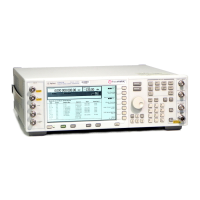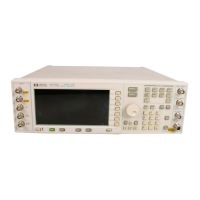Chapter 18 649
Troubleshooting
Basic Signal Generator Operations
There are three power search modes: manual, automatic, and span.
When
Power Search is set to Manual, pressing Do Power Search executes the power search calibration routine
for the current RF frequency and amplitude. In this mode, if there is a change in RF frequency or amplitude,
you will need to press
Do Power Search again.
When
Power Search is set to Auto, the calibration routine is executed whenever the frequency or amplitude of
the RF output is changed.
When
Power Search is set to Span, pressing Do Power Search executes the power search calibration routine
over a selected range of frequencies at one time. The power search corrections are then stored and used
whenever the signal generator is tuned within the selected range of frequencies.
RF Output Power too Low
1. Look for an OFFS or REF indicator in the AMPLITUDE area of the display.
OFFS tells you that an amplitude offset has been set. An amplitude offset changes the value shown in the
AMPLITUDE area of the display but does not affect the output power. The amplitude displayed is equal to
the current power output by the signal generator hardware plus the value for the offset.
To eliminate the offset, press the following keys:
Amplitude > More (1 of 2) > Ampl Offset > 0 > dB.
REF tells you that the amplitude reference mode is activated. When this mode is on, the displayed
amplitude value is not the output power level. It is the current power output by the signal generator
hardware minus the reference value set by the
Ampl Ref Set softkey.
To exit the reference mode, follow these steps:
a. Press
Amplitude > More (1 of 2).
b. Press
Ampl Ref Off On until Off is highlighted.
You can then reset the output power to the desired level.
2. If you are using the signal generator with an external mixer, see “Signal Loss While Working with
Mixers” on page 646.
3. If you are using the signal generator with a spectrum analyzer, see “Signal Loss While Working with
Spectrum Analyzers” on page 647.

